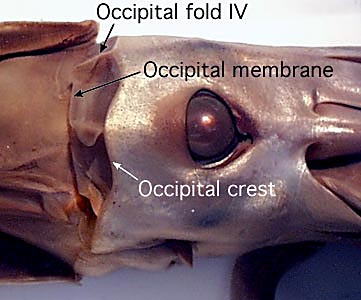The occipital region is the back of the head. The occipital crest is a ridge that marks the posterior edge of the sides and top of the head. The occipital crest extends from the posterior margin of the funnel groove dorsally sometimes to the where it joins its counterpart from tthe opposite side but more often fading out before this. Occipital folds extend posteriorly from the occipital crest on the back of the head . Typically four occipital folds exist on each side but the number varies from zero to ten or more. At their posterior ends, the occipital folds connect to the occipital membrane. The latter is best developed between folds two through four. The membrane between folds one and two is not quite continuous with the major membrane. Often a minor membrane will extend from the fourth fold to some of the more dorsal folds (when present); this membrane, however, is not continuous with the main membrane. The function of the occipital folds and membranes are not known but they must affect the flow of water into the mantle cavity. The olfactory organ lies on the edge occipital membrane adjacent to fold number one.


Figure. Lateral view of the head and occipital region of a preserved Sthenoteuthis oualaniensis (fam. Ommastrephidae) shows the squid with the mantle muscle removed from the side, leaving longitudinal sections of the muscle at the top and bottom of the photograph. Photograph by R. Young.




 Go to quick links
Go to quick search
Go to navigation for this section of the ToL site
Go to detailed links for the ToL site
Go to quick links
Go to quick search
Go to navigation for this section of the ToL site
Go to detailed links for the ToL site